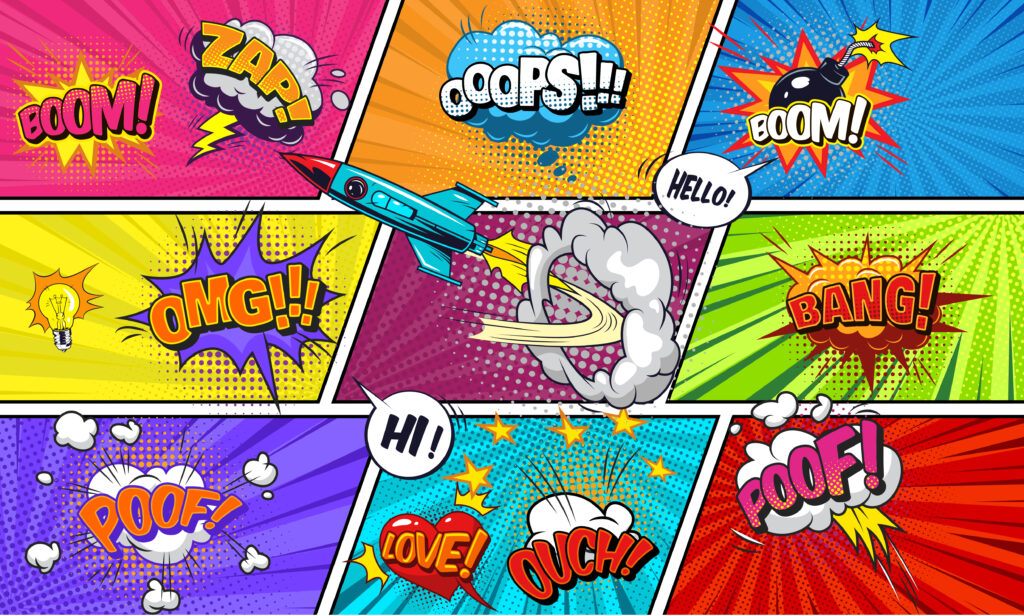AI Generated artwork has no place in the comic book industry

nine colorful blank comic book page template background
With 30+ years experience in marketing, YouLovePrint’s Online Business Development Director Kelly Harris describes himself as a “passionate believer in the power of ink on paper”. When it comes to comic books and, more specifically, comic book printing, he recognises the danger AI presents not just to the professional community of creatives, but also the culture and importance of comic books overall.
Recently, AI was used to create the images in the opening sequence of the Marvel series ‘Secret Invasion’, causing a buzz – both good and bad – amongst not just the audience, but also the wider communities of artists, film-makers and comic book creators.
From a consumer standpoint, it’s incredibly cool to think that AI can create these images. However, its inclusion in the product of a multi-billion dollar company has likely only aggravated existing concerns for the future of artistic communities, many of whom may already have been impacted by the rise in AI-generated artwork.
Artists, animators and creatives of all shapes and sizes will likely nod in unison at the suggestion that AI is not welcome in their respective communities, and it’s not just the potential for job loss that forms this opinion.
The art form of comic books
In the comic book world, the legacy of the legends such as Stan Lee, Jack Kirby, Robert Kane, and Frank Miller is intact with those who love the genre. To become the best in this artform takes time, hard work, and dedication – and it’s the commitment of artists (and creators in general) that marks their work with a legendary status. It’s inspiring that the original creators and artists that grew the genre over decades remain such popular figures, even at a time when the comic world is bigger than ever before thanks to the arrival of blockbuster, behemoth movie franchises.
In 1963, Jack Kirby pencilled the first issue of The Avengers, based on a script written by Stan Lee. The lines were rendered by a professional, a colourist was hired to paint each panel based on a colour guide to ensure that separations were made by hand, and then it was sent off to print.
Today, various tools exist to aid the process of comic book creation, which has helped speed things up, but you still need expertise, an eye for detail and – perhaps most importantly – a healthy dose of both flexibility and creativity to make it work. The methods of creating comic book art may have changed over the years, but it is still a painstaking and deliberate artform that requires skill and craft from multiple individuals before a comic book makes it to the shelves.
The advent of AI could change that. While you could (rightly) argue that AI can be used as just another “tool” to grant an individual artist a faster, more cost-effective and simpler way to create art, it also has the potential to completely replace human artists and remove them from the craft of comic book creation forever, if we’re not careful.
Admittedly, that’s a very surface-level view of the situation. While AI could indeed remove the need for human creators, there’s also the question of whether or not the consumers – the comic book fans – actually want it to.
The ‘lack of’ appetite from fans of the genre
Recently, a Twitter post of an AI-created Batman comic brought a lot of conversation on the topic of AI-generated artwork. The post shared a four panel comic story including Batman, Robin, and the Joker, using the latest OpenAI image generation model. Although there was some positive feedback on the creation, the majority of the feedback was negative.
For some people, the use of AI is no different to just cutting up a physical comic book and stitching it back together to call it your own. This is a fair analogy, given how AI works to generate responses to prompts.
How AI is used to create art
At the moment, users feed AI tools information about the past work and style of the artists or form they’re trying to (re)create. This may include descriptions of characters and images, from which new images are generated through learned knowledge. The idea is that over time, the more information AI takes in and processes, the closer it will be to creating an authentic piece of art. A human must input the information and the parameters, but it is not a human that draws and puts together the art. Furthermore, at this stage, it’s generally accepted that AI isn’t “creating” its own work – it’s simply drawing elements from the information it’s already received. One could argue that, at a base level, the same can be said of human creators, but there’s an important difference between humans and AI.
The definition of creativity
The fact is, AI does not contain the emotion and that creative spark that does shine through in any human artform, whether it is comic book art, creating music, or writing. Fans of AI see it as another tool for artists to use, in the same way there was a backlash when the drum machine came into popular use in the 1980s, and currently it cannot create full art on its own.
This, as one might expect, has presented some legal issues at both ends of the spectrum.
Copyright concerns with AI
Artists, creators, and legislators are attempting to get to grips with AI and copyright concerns as this new age of artificial intelligence begins to impact all areas of our lives. We’ve already had instances of companies that use AI being sued, with Getty Images suing Stable Diffusion for copying and processing images without obtaining licences earlier in the year. There have been others calling for brand-new guidelines around the use of AI-generated art, from prominent figures such as Ken Akamatsu, a Japanese manga artist turned politician.
His suggestion is that art creators should have the right to exclude their work from datasets that are used to train AI programs, or at the very least be compensated for any work that is used within these processes to create ‘new’ art. There is an argument that AI could be used as a smart tool to help creators and artists with the time consuming aspects of their craft and allow them to create even more great pieces of art.
Recently, the US Copyright Office has limited the scope of protection afforded to comic books that have used AI to create images. It could be that protections are found elsewhere, for instance in the copyright and trademark protections that are available for some fictional characters. If this remains the only limit on AI-generated comic book art it could signal a seismic shift in the world, putting the livelihood of comic book artists and creators at risk, in much the same way that AI is seen as a threat to the world of writing, and the world of music and movies.
The speed and relative ease at which AI tools can generate art and animation is indeed technologically impressive and, for some, highly convenient, but it completely strips away the proverbial “blood, sweat and tears” that artists pour into their endeavours – which is what makes them impressive in the first place. We talk about things being “made with love”, and comic books most certainly are – and this is what has made them a beloved form of entertainment and artistry for decades.
When asking AI if it was capable of love, it responded with a very flat comment; “I don’t possess feelings, emotions, or consciousness, so I don’t experience love. My responses are generated based on patterns and information from the data I was trained on, rather than any kind of emotion or preference”.
AI might well be able to create gorgeous images on command, but in this writer’s opinion, it’s missing the crucial ingredient that transforms an image into true “art”.




